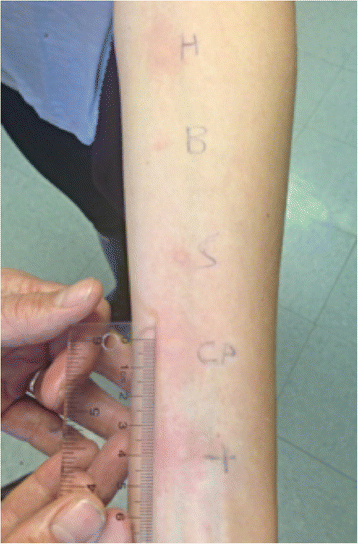Food-dependent exercise-induced anaphylaxis to chickpea in a 17-year-old female: a case report
- PMID: 26334308
- PMCID: PMC4559180
- DOI: 10.1186/s13256-015-0669-6
Food-dependent exercise-induced anaphylaxis to chickpea in a 17-year-old female: a case report
Abstract
Introduction: Food-dependent exercise-induced anaphylaxis is a subtype of anaphylaxis and, although rare, it is an important condition to be familiar with as it can ultimately lead to death.
Case presentation: We present a case of food-dependent exercise-induced anaphylaxis in a 17-year-old white girl due to chickpea. She had a history of anaphylaxis after eating crackers and hummus before exercising. Skin prick testing and serum-specific immunoglobulin E level confirmed chickpea to be the causative allergen.
Conclusions: This case demonstrates the challenge in identifying specific causative food allergens when foods are eaten in combination, when the food is processed, and when cross-reactivity is possible. These challenges add complexity to a condition that is already rare and unfamiliar to some health care providers. We hope that this case will serve as an important reminder that although rare, food-dependent exercise-induced anaphylaxis exists and making a diagnosis can lead to life-saving preventative strategies. As legumes are not a common food associated with food-dependent exercise-induced anaphylaxis, this will add to our current knowledge base in the field of allergy.
Figures
Similar articles
-
Food-dependent exercise-induced anaphylaxis to lentil and anaphylaxis to chickpea in a 17-year-old boy.J Investig Allergol Clin Immunol. 2008;18(6):465-8. J Investig Allergol Clin Immunol. 2008. PMID: 19123439
-
Latex and chickpea (Cicer arietinum) allergy: first description of a new association.Eur Ann Allergy Clin Immunol. 2004 Dec;36(10):366-71. Eur Ann Allergy Clin Immunol. 2004. PMID: 15662964
-
Food-dependent exercise-induced anaphylaxis with a high level of plasma noradrenaline.J Dermatol. 2007 Feb;34(2):110-3. doi: 10.1111/j.1346-8138.2006.00227.x. J Dermatol. 2007. PMID: 17239147
-
Recent advances of in vitro tests for the diagnosis of food-dependent exercise-induced anaphylaxis.J Dermatol Sci. 2013 Sep;71(3):155-9. doi: 10.1016/j.jdermsci.2013.04.010. Epub 2013 Apr 22. J Dermatol Sci. 2013. PMID: 23669019 Review.
-
Food-Dependent, Exercise-Induced Anaphylaxis: Diagnosis and Management in the Outpatient Setting.J Allergy Clin Immunol Pract. 2017 Mar-Apr;5(2):283-288. doi: 10.1016/j.jaip.2016.11.022. J Allergy Clin Immunol Pract. 2017. PMID: 28283153 Review.
Cited by
-
A Case of Possible Monosodium Glutamate-Dependent, Exercise-Induced Anaphylaxis.Cureus. 2019 Aug 8;11(8):e5345. doi: 10.7759/cureus.5345. Cureus. 2019. PMID: 31602350 Free PMC article.
-
Legume Allergens Pea, Chickpea, Lentil, Lupine and Beyond.Curr Allergy Asthma Rep. 2024 Sep;24(9):527-548. doi: 10.1007/s11882-024-01165-7. Epub 2024 Jul 11. Curr Allergy Asthma Rep. 2024. PMID: 38990406 Free PMC article. Review.
-
IgE-Mediated Legume Allergy: A Pediatric Perspective.J Pers Med. 2024 Aug 25;14(9):898. doi: 10.3390/jpm14090898. J Pers Med. 2024. PMID: 39338152 Free PMC article. Review.
-
Diagnosis of exercise-induced anaphylaxis: current insights.J Asthma Allergy. 2016 Oct 27;9:191-198. doi: 10.2147/JAA.S109105. eCollection 2016. J Asthma Allergy. 2016. PMID: 27822074 Free PMC article. Review.
References
-
- Sampson HA, Munoz-Furlong A, Campbell RL, Adkinson NF, Jr, Bock SA, Branum A, et al. Second symposium on the definition and management of anaphylaxis: summary report – Second National Institute of Allergy and Infectious Disease/Food Allergy and Anaphylaxis Network Symposium. Ann Emerg Med. 2006;47:373–80. doi: 10.1016/j.annemergmed.2006.01.018. - DOI - PubMed
Publication types
MeSH terms
Substances
LinkOut - more resources
Full Text Sources
Other Literature Sources
Medical
Research Materials


